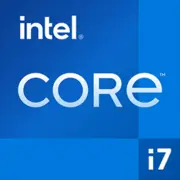Intel Core i7-8700K

Intel Core i7-8700K in 2025: Is it worth considering an outdated processor?
April 2025
1. Key Features: Architecture and Performance
Codename and Technology Process
The Intel Core i7-8700K, released in 2017, belongs to the Coffee Lake generation. It is one of Intel's first 6-core processors aimed at the consumer market. The technology process is 14 nm, which is considered outdated by 2025 (modern chips use 5-7 nm). However, at the time of its release, it was a breakthrough: 6 cores and 12 threads with a base frequency of 3.7 GHz and Turbo Boost up to 4.7 GHz.
Key Features
- Hyper-Threading: 12 threads for multitasking.
- Unlocked Multiplier: Overclocking capability (though not all motherboards support it).
- Integrated Graphics: Intel UHD Graphics 630 — suitable for office tasks or emergencies, but not for gaming.
- L3 Cache: 12 MB — sufficient for reducing latency in games and applications.
Performance
According to Geekbench 6 (2025):
- Single-Core: 1576 points — a modest result for 2025 (modern processors score 2000+).
- Multi-Core: 6433 points — acceptable for basic work tasks but lags behind even budget Ryzen 5 7500F (around 8000 points).
Practical Example: In 2023, a user on Reddit built a PC with an i7-8700K and RTX 3060 for gaming at Full HD. In 2025, such a system still runs Cyberpunk 2077 at medium settings (45-60 FPS), but experiences drops in CPU-intensive scenes.
2. Compatible Motherboards: What to Choose in 2025?
Socket and Chipsets
The processor uses LGA 1151 v2. Compatible chipsets include:
- Z370: For overclocking (e.g., ASUS ROG Strix Z370-E).
- H370/B360/H310: Budget boards without overclocking.
Selection Tips
- New Boards: No longer produced. In 2025, only used options remain (price: $50-100) or leftover new ones (up to $150).
- Limitations: No support for PCIe 4.0/5.0, USB 3.2 Gen 2x2, Thunderbolt 4.
- Advice: Look for boards with reliable VRM (e.g., MSI Z370-A Pro) — they handle overclocking better.
3. Supported Memory Types
DDR4-2666: Maximum speed without overclocking. Compatible with modules up to 64 GB (depends on the motherboard).
No DDR5: In 2025, this is a critical downside — new games and applications are optimized for high-speed memory.
Recommendations:
- Use 2 DDR4-3200 modules (in XMP mode) for a small performance boost.
- Example: 16 GB Kingston Fury DDR4-3200 (around $60 for a set).
4. Power Supply Units: How Many Watts Do You Need?
Processor TDP: 95 W, but with overclocking, consumption can reach 140-150 W.
Recommendations:
- Without a discrete graphics card: A 400 W PSU (e.g., be quiet! Pure Power 11 400W, $55).
- With a graphics card like the RTX 4060: A 550-650 W PSU (Corsair RM650x, $90).
- Important: Choose units with an 80+ Bronze certification or higher.
5. Pros and Cons of the i7-8700K in 2025
Pros:
- Affordable price: New processors (if available) are $150-200 compared to $250-300 for the Ryzen 5 7600.
- Good multi-core performance for older applications.
- Overclocking potential (up to 5.0 GHz with good cooling).
Cons:
- Outdated technology process: High power consumption and heat output.
- No support for modern standards (PCIe 4.0, DDR5).
- Challenges with upgrades: New GPUs and SSDs may not operate at full speed.
6. Use Cases
Gaming:
- Full HD/Medium Settings: CS2, Fortnite, GTA V — 60+ FPS.
- Modern AAA Titles: FPS drops may occur due to CPU limitations (e.g., Starfield).
Work Tasks:
- Video Editing: In Premiere Pro, rendering 1080p videos will take 20-30% longer than on the Ryzen 5 7600.
- 3D Modeling: Suitable for basic use in Blender.
Multimedia:
- Streaming via Plex.
- Office applications and web browsing.
7. Comparison with Competitors
AMD Ryzen 5 3600 (2019):
- Cheaper ($100-120 used), but worse in single-core performance (Geekbench 6: ~1400).
- Supports PCIe 4.0 (with a BIOS update).
Intel Core i5-12400F (2022):
- Newer, higher IPC, supports DDR4/DDR5.
- Price for new units: $180-200.
Conclusion: The i7-8700K falls behind modern budget CPUs but outperforms older models thanks to its 12 threads.
8. Assembly Tips
- Cooling: A cooler like the DeepCool AK400 ($35) or the Arctic Liquid Freezer II 240 (for overclocking).
- Motherboard: Look for models with USB 3.1 and M.2 NVMe (e.g., Gigabyte Z370 Aorus Gaming 5).
- Upgrade: If you already have an LGA 1151 v2 board, the i7-8700K is a good replacement for an i3/i5. For new builds, consider the AM5 or LGA 1700 platforms.
9. Final Conclusion: Who is the i7-8700K Suitable For?
This processor is worth considering:
1. For upgrading older systems: If you already have a compatible motherboard.
2. Budget builds: When you need to save money while getting 6 cores.
3. Enthusiasts: For experimentation with overclocking on the second-hand market.
Alternative: If the budget allows, it's better to get the Ryzen 5 7600 or Intel Core i5-13400F — they offer DDR5 and PCIe 5.0 support for a small premium.
In 2025, the i7-8700K is a "workhorse" for niche tasks but not a foundation for a future-oriented system.
Basic
CPU Specifications
Memory Specifications
GPU Specifications
Miscellaneous
Benchmarks
Compared to Other CPU
Share in social media
Or Link To Us
<a href="https://cputronic.com/en/cpu/intel-core-i7-8700k" target="_blank">Intel Core i7-8700K</a>